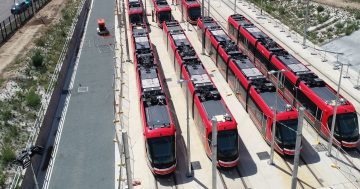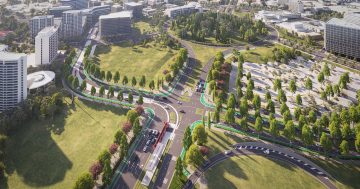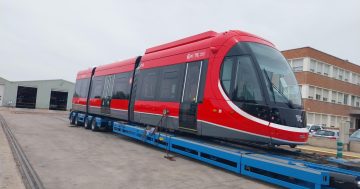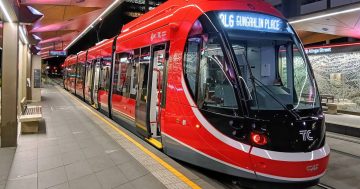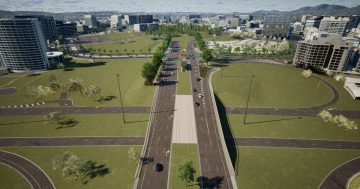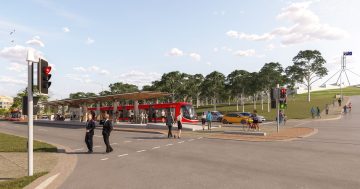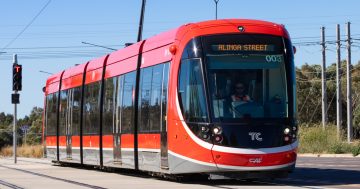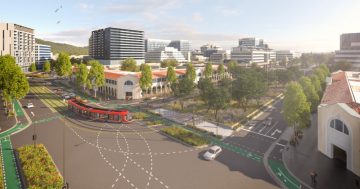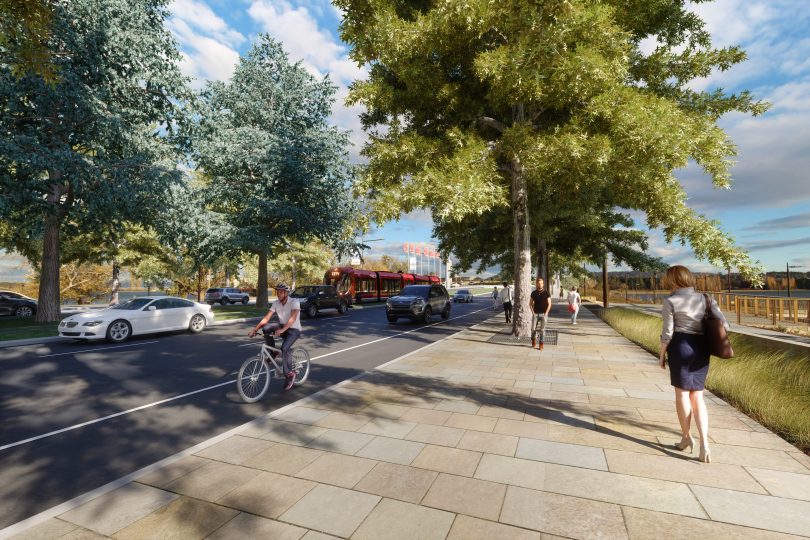
A render of light rail on Commonwealth Avenue at the Commonwealth Park end of the northern section of Stage 2.
There will be more wire-free running and up to 10 new bridges, including the crossing of Parkes Way and Lake Burley Griffin between the City and Woden as part of the light rail Stage 2 project, according to documents lodged with the Commonwealth by the ACT Government.
The Government has split the route into two sections and last week lodged two referrals detailing the project requirements under the Environment Protection and Biodiversity Conservation Act.
The documents are now open to public comment and reveal more of the detail of how the two sections of Stage 2 to Woden would be built.
Transport and City Services Minister Chris Steel said the decision to split the route provided an opportunity to fast-track the first stage from the City to Commonwealth Park while the Government worked through the more complex later stage through the Parliamentary Triangle with the Federal Government.
“We hope that the Federal Government agrees to the proposal to split light rail stage two into two parts,” he said.
As well as the expected wire-free running through the Parliamentary Zone, the ACT Government also plans to make the 1.7km City to Commonwealth Park leg, which is presented as a self-contained proposal, wire-free, with light rail vehicles charging at the three new stops of City West, West Basin and Commonwealth Park.
LRVs will have their own on-board power supply and a traction power substation in Commonwealth Park, connected to the system at Commonwealth Avenue which will need to be built.
The first leg will also require a dedicated light rail ramp between London Circuit and Commonwealth Avenue, using the existing road off-ramp and necessitating an adjustment to the ‘cloverleaf’, and a new bridge between the existing bridges along Commonwealth Avenue over Parkes Way.
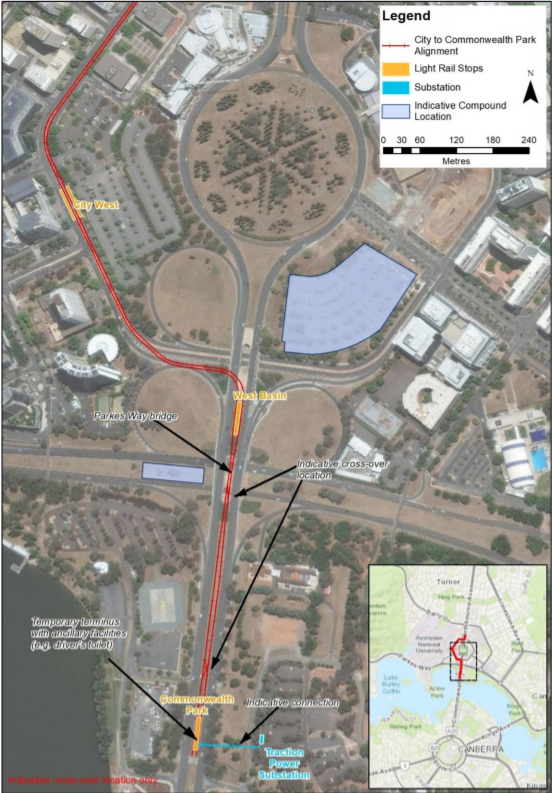
A pedestrian and traffic shared-zone on London Circuit between Gordon Street and Edinburgh Avenue is planned to improve accessibility to the City West light rail stop.
Major Projects Canberra may use alternative track slab surface treatments for sections of the City to Commonwealth Park alignment, including grass tracks on Commonwealth Avenue or a paved track slab surface on London Circuit, to better integrate the design into landscape.
It has split the first leg into two precincts – a ‘complex urban environment at London Circuit and then down the nationally-significant Main Avenue of Commonwealth Avenue’ – to ensure the project is integrated into the different landscapes.
At least four new LRVs will be required for the first leg, which the Government hopes will be up and running by 2023, and the Mitchell depot will also need to be expanded.
There will also be a ‘scissor cross-over’ at the Commonwealth Park end to allow light rail vehicles to reverse direction and travel northbound.
For the more c0mplex 9km, nine-stop Stage 2B across the lake to Woden via State Circle East, another 12 LRVS will have to be added to the fleet. The Government hopes it can be in operation in 2025 but with more environmental and heritage hurdles and the engineering challenges that start at Lake Burley Griffin and continue past Parliament House, this may be optimistic.
As well as the new bridge across Lake Burley Griffin, other bridges will need to be built on Commonwealth Avenue over Flynn Drive, Adelaide Avenue over State Circle, and over Yarralumla Creek.
New pedestrian bridges are planned for over Adelaide Avenue to the Kent Street light rail stop and over Yarra Glen to the Carruthers Street light rail stop, as well as a new pedestrian and cycle bridge across Yarralumla Creek at Phillip.

The road vehicle bridge from Yamba Drive to Melrose Drive will need to be decommissioned as will the pedestrian bridge across Yarralumla Creek at Phillip.
Four new traction power substations, 30 metres long by about 10 metres wide will be needed to service the project, and the documents say they would be located to avoid tree loss or impacts on canopies or roots.
They will be connected to each other via a Combined Service Route that follows the track slab alignment, while to the south, there will be a further trenched connection to the Evo Energy Woden Bulk Supply point sub-station.
Temporary construction compounds will be needed along the route including extra land on State Circle, Capital Hill, which will result in the temporary loss of parking.
A compound midway across the lake under the existing bridges may be used, involving sheet piling and a temporary working platform.
Driver amenities are planned at the end of both legs, at Commonwealth Park and Woden.
The ACT Government is hoping for quick approval for the City to Commonwealth Park with limited environmental and heritage impacts, including the presence of the critically endangered golden sun moth at the intersection of London Circuit and Commonwealth Avenue, and possible affects on the Reserve Bank building and the Parliamentary vistas.
But Commonwealth Park to Woden presents multiple impacts. As well as the golden sun moth in the cloverleaf to negotiate, there are the historic Weston tree plantings, the Parliamentary vistas, possible impacts on West Block, Parliament House, State Circle Cutting, the York Park oak plantation, and the Lodge.
The referral argues these can be minimised and offset by defined no-go and protection zones, sensitive design, ‘grass tracks’, wire-free running and a landscaping and tree replacement program, including propagating a series of next-generation Himalayan cedars from the original trees on Commonwealth Avenue.
The City to Commonwealth leg requires approval from the ACT planning authority and the National Capital Authority, while the other section to Woden needs to be approved by the Federal Parliament as well. The second leg also faces the prospect of more environmental and heritage conditions being imposed on it.
The business cases for both legs are expected to be finalised in the next couple of months, when a better idea of the real cost will be known.
The entire Stage 2 has had an estimated price tag of up to $1.6 billion.













